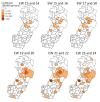Emergence of Oropouche Virus in Espírito Santo State, Brazil, 2024
- PMID: 40401583
- PMCID: PMC12123935
- DOI: 10.3201/eid3106.241946
Emergence of Oropouche Virus in Espírito Santo State, Brazil, 2024
Abstract
Oropouche virus (OROV), historically endemic to the Amazon, had spread to nearly all Brazil states by 2024; Espírito Santo emerged as a transmission hotspot in the Atlantic Forest biome. We characterized the epidemiologic factors driving OROV spread in nonendemic southeast Brazil, analyzing environmental and agricultural conditions contributing to viral transmission. We tested samples from 29,080 suspected arbovirus-infected patients quantitative reverse transcription PCR for OROV and dengue, chikungunya, Zika, and Mayaro viruses. During March‒June 2024, the state had 339 confirmed OROV cases, demonstrating successful local transmission. Spatial analysis revealed that most cases clustered in municipalities with tropical climates and intensive cacao, robusta coffee, coconut, and pepper cultivation. Phylogenetic analysis identified the Espírito Santo OROV strains as part of the 2022-2024 Amazon lineage. The rapid spread of OROV outside the Amazon highlights its adaptive potential and public health threat, emphasizing the need for enhanced surveillance and targeted control measures.
Keywords: Brazil; Oropouche virus; arboviruses; climate; disease outbreaks; epidemiology; symptoms; vector-borne infections; viruses.
Figures





References
MeSH terms
Supplementary concepts
LinkOut - more resources
Full Text Sources

